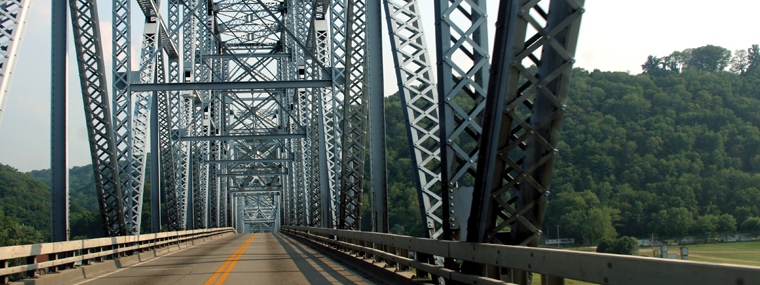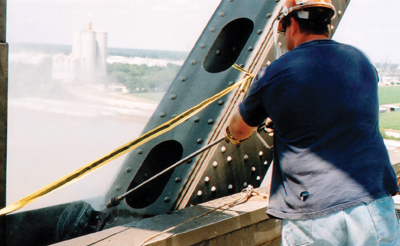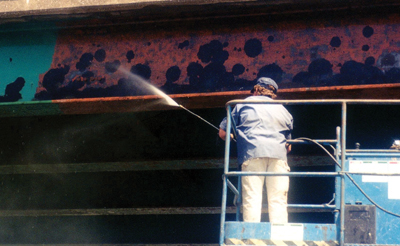
Bridge Washing: There Is No Typical Job
Contributor Jim Johnson, National Association of Corrosion Engineers Certified Level III Coating Inspector #2383, Marketing and Technical Support, CHLOR*RID International, Inc., Chandler, AZ / Published February 2014

Editor’s Note: This is a new entry in the revision of the 2002 Power Washers’ Guidebook.
Geographical Considerations
There are few geographical limitations for pressure washing bridges, though in many instances, accommodations must be made for freezing weather. Other considerations are structures within a containment system and/or environmental concerns, which can vary geographically—particularly by state.
Typical Job
The only thing typical about bridge washing is that there is no typical job. Each project has its own considerations and requirements. For example, often times weather can turn cold, below freezing, and a contractor may have to use a heated pressure washer. These units are readily available in two types. The heater may be built into the base unit, or, if the pressure washer does not have the ability to provide hot water, a separate heating unit can be installed on the pressurized outlet side of the washer to heat the water as it is pumped through the heating unit. Stand-alone heaters can be added to almost any pressure washer as long as the heating unit is rated for or above the pressure of the pressure washer itself.
Many bridge painting specifications require full containment of the structure before surface preparation can begin. Containment may be required because of lead paint or dust considerations. Once the containment is erected, pressure washing is not acceptable as there is no way to collect and dispose of the water. (Pressure washing inside a containment area would be like pressure washing inside a tent with a waterproof floor. There simply is no place to go with the spent water and such containment structures will not hold the weight of the water.) If pressure washing is required, it must be accomplished before the containment is erected.
Some state environmental regulations require all water from bridge washing to be captured. Though bridges are frequently washed by rain, which is not captured, any water used by man must be captured to be certain no wash water containing grime or oils reaches or pollutes the soil or water beneath a bridge. Due to the cost of capturing the water, most states with such wastewater capture regulations do not pressure wash bridges as part of the normal painting operation.
A contractor could consider opportunities limited when one looks at the imposing regulations and the cost of compliance. This limitation is based more on the individual state than any particular region.
Techniques that Work Best
 The key to success is pretty simple. As I used to tell our crew, think of the hardest, most tedious way to do the job and that is probably the right way to do it. The simple, easy, shortcut method never works. All shortcuts do are lead to re-work and customer dissatisfaction.
The key to success is pretty simple. As I used to tell our crew, think of the hardest, most tedious way to do the job and that is probably the right way to do it. The simple, easy, shortcut method never works. All shortcuts do are lead to re-work and customer dissatisfaction.
Be sure the operator of equipment is properly trained and informed of cleaning procedures. Be aware of any safety procedures required, such as fall protection or other personal protective equipment (PPE); and follow the procedures scrupulously.
Traffic control can be a major work barrier, so be aware of requirements and insist on a pre-work meeting where any and all requirements can be explained, questions answered, and possible problems discussed.
Exceptions
The best technique is to do the job as best you can. There are few exceptions to that rule and none come to mind. Typically the entire bridge is cleaned in the same manner, but some areas have limited access so more care has to be taken to be sure all is adequately cleaned. Corners, joints, crevices, and other such areas require special attention, just as a surgeon pays special attention to scrubbing his hands—versus how we wash our hands before eating lunch.
Equipment and Supplies
Although there is no typical job and each project has its own considerations and requirements, typical items required would be the most essential items, such as: 1) a 3000–3500 psi pressure washer equipped with a zero-degree, rotating nozzle—leave your fan nozzles at home; 2) a located or provided water source; 3) a located or provided means to dispose of spent wash water; 4) a low pH chemical specifically for salt removal, if salts are to be removed.
A basic list of equipment and supplies includes: 1) raincoats; 2) hard hats with face shields; 3) waterproof gloves; 4) water hoses; 5) water tanks, drums, or water truck; 6) fall protection devices; 7) breathing apparatus; 8) air-monitoring equipment; 9) OSHA-approved extension cords; 10) portable generator; 11) gas and diesel fuel cans; 12) portable lighting; 13) portable heaters; 14) lumber and tarps for temporary containment; 15) several large wet/dry shop vacuums; 16) 300 ft of pressure washer hose in 50-ft lengths; 17) hand tools adequate to repair any equipment on a job site; 18) fiberglass step ladders—various height; 19) fiberglass extension ladders—various height; 20) portable eye wash station; 21) trash cans and bags; 22) rubber irrigation boots—various sizes; 22) cold weather gear for workers, if required by location; 24) Tyvek overalls in large quantity. (As a general rule, anything lying around your garage that you are sure is not needed will be needed on the next job.)
How to Bill
There are several books available that explain different methods of determining how to bid work. In most cases, a contractor will estimate how many man-hours a job will take, calculate the cost per hour, add any materials, and then add a percentage for profit. It can be very simple or very complicated, but no one method works for everything. That is where the experience factor comes in.
Experience is the absolute best teaching method. The first time a person loses $5,000 on a job, they look back at costs and learn a lot about true cost. The first time a $40,000 job has to be re-done out of pocket one immediately learns how it happened and to never allow it to happen again.
There is a quick, easy bidding formula many contractors use: If you do not win 60 percent of what you bid, then you are bidding too high. If you win more than 60 percent of your bids, you are leaving too much on the table. The 60 percent is not an absolute number, but it gives a person a target or goal to aim for. That percentage could vary greatly for different types of projects—and factoring in the amount of competition. (The best bidding advice I can give is that if someone grossly underbids you, then let them have it. Do not bother to attempt to compete with them as they will not be around long.)
Ancillaries
Do your best to identify any possible add-ons at the pre-work meeting. Take the opportunity, for example, to point out to an owner or general contractor that salts should be removed if the coating is to be successful.
Customers hate surprises and will appreciate having you identify up front any add-ons or something they missed. Some contractors bid cheap and then make it up in add-ons. They may make money, but they are seldom invited back.
Problem Areas to Avoid
Virtually anything can go wrong if the work is not done adequately. Some contractors end up doing re-work on over half the jobs they do. They are constantly struggling to stay alive and seldom make a profit.
How to Fix Mistakes
Do the best quality of work you can do, and it will pay off. Owners and general contractors look for the job to be done correctly, according to their specifications and then notice excellent work.
 As an example of how sound methods and good results get noticed, consider this: We were a coating applicator company and did a lot of coating work for a major manufacturer. We pressure washed and cleaned everything before we coated anything. This manufacturer had in-plant areas they had pressure washed weekly and monthly. They could never find a pressure washing company that did a good enough job to satisfy them, but then they observed how we pressure washed prior to applying coatings and identified the quality of work they desired. The result was they offered us a $1 million blanket purchase order just to do their pressure washing.
As an example of how sound methods and good results get noticed, consider this: We were a coating applicator company and did a lot of coating work for a major manufacturer. We pressure washed and cleaned everything before we coated anything. This manufacturer had in-plant areas they had pressure washed weekly and monthly. They could never find a pressure washing company that did a good enough job to satisfy them, but then they observed how we pressure washed prior to applying coatings and identified the quality of work they desired. The result was they offered us a $1 million blanket purchase order just to do their pressure washing.
We billed the owner of the plant an hourly rate, including overtime for night work, and billed against that purchase order. When the $1 million was used up, they issued another purchase order to replace it. As long as we did not overcharge our hours and did good quality work, they were satisfied. We worked for that firm for more than five years before we retired out of that business and never did have to bid anything we did for them. All they wanted was top-quality work for an economical price.
Jim Johnson has over 20 years of experience in protective coating sales, application, and inspection. He has provided coating application services to many firms including Stone Container, Asarco Mining, and Phelps Dodge Mining. He is the author of numerous technical articles published in the Journal of Protective Coatings and Linings and Materials Performance; and he is the author of the first comprehensive Guide to Field Testing for Soluble Salts.




